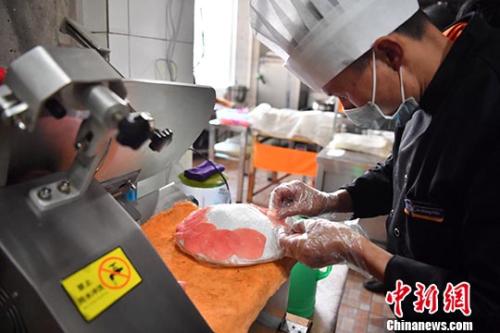New recipes at Tibetan restaurants in Shangri-La
Traditionally, the Tibetans in Shangri-La, northwest Yunnan’s Diqing Tibetan Autonomous Prefecture, enjoyed the dishes of zanba (roasted qingke barley flour), Pipa pork, earthen hot pots, water-simmered cake, milk dregs, and barley porridge.

Now, the new dishes in this area include crispy pork ribs, braised beef, black fungus in vinegar sauce, fried crown daisy and others. Of these, the trendiest in Shangri-La is “yak sashimi,” or thinly sliced yak-meat eaten raw.
Located in the southeast of the Qinghai-Tibet Plateau, Shangri-La used to be a key stop on the ancient Tea-Horse Road, where merchants from different localities met and the ethnic groups of Tibetan, Han, Naxi, Yi and Bai live in harmony.
Thanks to the ancient trading route, Shangri-La has been a place of openness since ancient times. In recent years, such openness has been increasingly shown at the novel dishes in local Tibetan restaurants, along with improved transport facilities and growth in tourism.
"Tibetan dishes in Shangri-La are mostly stewed or cooked, and I was at first good at braising beef and frying pork ribs," said Nainima, aged 50, who used to be a popular chef for local wedding or funeral feasts.
It was in his flowering years when Nainima saw Shangri-La bring in droves of international tourists via its ancient city of Dukezong, snow-capped peaks, deep canyons, virgin forests, meadows and lakes. As a result, restaurants mushroomed in Shangri-La.
Years ago, Nainima opened a Tibetan restaurant at Dukezong. “I was good at traditional cuisine, but to meet the tastes of tourists, something new needs to be added to the old dishes.”
So, he employed a Han chef from central China, jointly developing novel dishes. Besides Tibetan food, they also formulated their own dishes with the Han, Naxi, Dai and Yi ethnic flavors.

Near Nainima’s thriving kitchen is yet another Tibetan restaurant featured by its yak-meat hot pot.
Borrowing the cooking method from central China, Ciren Zhuoma, the restaurant owner, puts the greens, mint, radish and others into the yak hot pot, giving off a small that stirs your taste buds.
“In high-altitude areas, Tibetans need to have much meat and butter tea,” said Tsering Zhuoma, adding Shangri-La was short of vegetables due to its climate and location.
In these years, the improved traffic facilities have brought in various vegetables and fruits, and locals in Shangri-La have also built up green houses to grow vegetables in the valleys.
Currently, vegetables account for nearly one third of the dishes at Tibetan restaurants in Shangri-La.
Like most Tibetan restaurant owners in Shangri-La, Zhaxi Peichu also created new recipes in his business, piloting an “ecological canteen”.
"In the eyes of Tibetans, everything is shared by all creatures, including humans, birds, insects, and others," said Zhaxi Peichu. "Tibetan farmers will not sprinkle pesticides or fertilizers to vegetables, allowing us to service tourists with green food.”
"Tibetans worship mother Nature, which, they believe, cannot be overly exploited," said Zhaxi Peichu. Local Tibetan seniors often talk with the restaurant owners about their philosophy between man and nature.
Reporting by Bao Xu and Miao Chao (China News Service); trans-editing by Wang Shixue